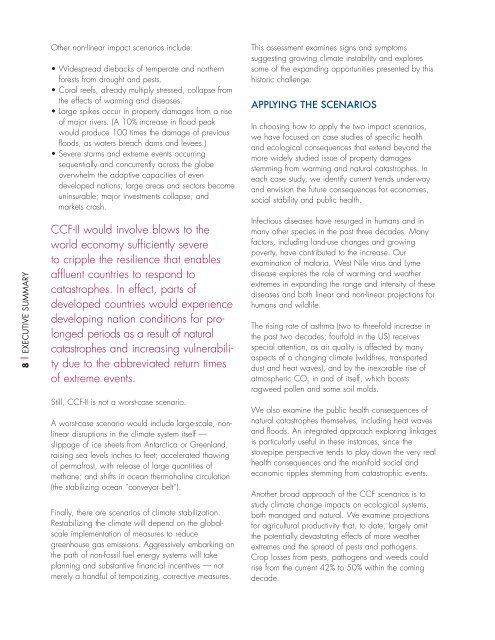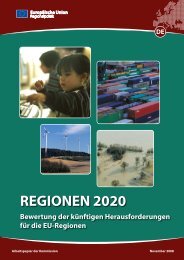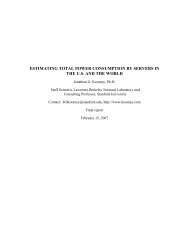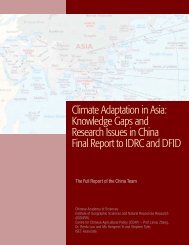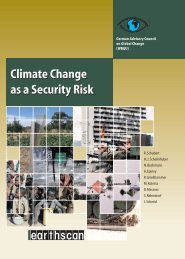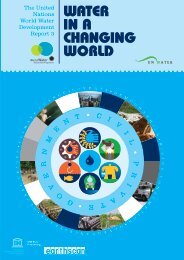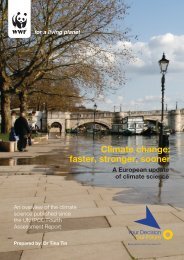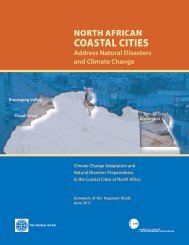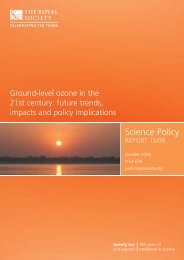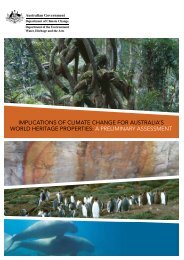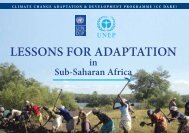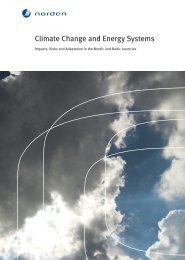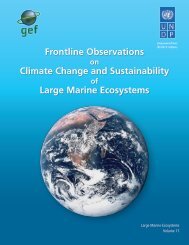the past decade, an increasing proportion of extremeweather events has been occurring in developednations (Europe, Japan <strong>and</strong> the US) (see chart onpage 6).The first impact scenario, or CCF-I, portrays a worldwith an increased correlation <strong>and</strong> geographicalsimultaneity of extreme events, generating anoverwhelming strain for some stakeholders. CCF-Ienvisions a growing frequency <strong>and</strong> intensity ofweather extremes accompanied by disease outbreaks<strong>and</strong> infestations that harm humans, wildlife, forests,crops <strong>and</strong> coastal marine systems. The events <strong>and</strong> theiraftermaths would strain coping capacities in developing<strong>and</strong> developed nations <strong>and</strong> threaten resources <strong>and</strong>industries, such as timber, tourism, travel <strong>and</strong> theenergy sector. The ripples from the damage to theenergy sector would be felt throughout the economy.In CCF-I, an accelerated water cycle <strong>and</strong> retreat ofmost glaciers undermine water supplies in someregions <strong>and</strong> l<strong>and</strong> integrity in others. Melting of permafrost(permanently frozen l<strong>and</strong>) in the Arctic becomes morepronounced, threatening native peoples <strong>and</strong> northernecosystems. And gradually rising seas, compoundedby more destructive storms cascading over deterioratingbarrier reefs, threaten all low-lying regions.Taken in aggregate, these <strong>and</strong> other effects of awarming <strong>and</strong> more variable climate could threateneconomies worldwide. In CCF-I, some parts of thedeveloped world may be capable of responding tothe disruptions, but the events would be particularlypunishing for developing countries. For the world over,historical weather patterns would diminish in value asguides to forecasting the future.The second impact scenario, CCF-II, envisions aworld in which the warming <strong>and</strong> enhanced variabilityproduce surprisingly destructive consequences. Itexplores a future rife with the potential for sudden,wide-scale <strong>health</strong>, environmental <strong>and</strong> <strong>economic</strong>impacts as climate <strong>change</strong> pushes ecosystems pasttipping points. As such, it is a future inherently morechaotic <strong>and</strong> unpredictable than CCF-I.Some of the impacts envisioned by the second scenarioare very severe <strong>and</strong> would involve catastrophic,widespread damages, with a world economy besetby increased costs <strong>and</strong> chronic, unmanageable risks.<strong>Climate</strong>-related disruptions would no longer becontained or confined.Threshold-crossing events in both terrestrial <strong>and</strong> marinesystems would severely compromise resources <strong>and</strong><strong>ecological</strong> functions, with multiple consequences forthe species that depend upon them. For example:• Repeated heat waves on the order of the 2003 <strong>and</strong>2005 summers could severely harm populations, killlivestock, wilt crops, melt glaciers <strong>and</strong> spreadwildfires.• The probability of such extreme heat has alreadyincreased between two <strong>and</strong> four times over the pastcentury <strong>and</strong>, based on an IPCC climate scenario,more than half the years by the 2040s will havesummers warmer than that of 2003.• Chronic water shortages would become moreprevalent, especially in semi-arid regions, such asthe US West.• With current usage levels, more environmentallydisplaced persons <strong>and</strong> a changing water cycle, thenumber of people suffering water stress <strong>and</strong> scarcitytoday will triple in two decades.VULNERABILITIES INTHE ENERGY SECTORImage: Photodisc• Heat waves generate blackouts.• Sequential storms disrupt offshore oil rigs, pipelines,refineries <strong>and</strong> distribution systems.• Diminished river flows reduce hydroelectric capacity<strong>and</strong> impede barge transport.• Melting tundra undermines pipelines <strong>and</strong> powertransmission lines.• Warmed inl<strong>and</strong> waters shut down power plantcooling systems.• Lightning claims rise with warming.Each stage in the life cycle of oil, includingexploration, extraction, transport, refining <strong>and</strong>combustion, carries hazards for human <strong>health</strong> <strong>and</strong> theenvironment. More intense storms, thawing permafrost<strong>and</strong> dried riverbeds, make every stage moreprecarious.7 | EXECUTIVE SUMMARY
8 | EXECUTIVE SUMMARYOther non-linear impact scenarios include:• Widespread diebacks of temperate <strong>and</strong> northernforests from drought <strong>and</strong> pests.• Coral reefs, already multiply stressed, collapse fromthe effects of warming <strong>and</strong> diseases.• Large spikes occur in property damages from a riseof major rivers. (A 10% increase in flood peakwould produce 100 times the damage of previousfloods, as waters breach dams <strong>and</strong> levees.)• Severe storms <strong>and</strong> extreme events occurringsequentially <strong>and</strong> concurrently across the globeoverwhelm the adaptive capacities of evendeveloped nations; large areas <strong>and</strong> sectors becomeuninsurable; major investments collapse; <strong>and</strong>markets crash.CCF-II would involve blows to theworld economy sufficiently severeto cripple the resilience that enablesaffluent countries to respond tocatastrophes. In effect, parts ofdeveloped countries would experiencedeveloping nation conditions for prolongedperiods as a result of naturalcatastrophes <strong>and</strong> increasing vulnerabilitydue to the abbreviated return timesof extreme events.Still, CCF-II is not a worst-case scenario.A worst-case scenario would include large-scale, nonlineardisruptions in the climate system itself —slippage of ice sheets from Antarctica or Greenl<strong>and</strong>,raising sea levels inches to feet; accelerated thawingof permafrost, with release of large quantities ofmethane; <strong>and</strong> shifts in ocean thermohaline circulation(the stabilizing ocean “conveyor belt”).Finally, there are scenarios of climate stabilization.Restabilizing the climate will depend on the globalscaleimplementation of measures to reducegreenhouse gas emissions. Aggressively embarking onthe path of non-fossil fuel energy systems will takeplanning <strong>and</strong> substantive financial incentives — notmerely a h<strong>and</strong>ful of temporizing, corrective measures.This assessment examines signs <strong>and</strong> symptomssuggesting growing climate instability <strong>and</strong> exploressome of the exp<strong>and</strong>ing opportunities presented by thishistoric challenge.APPLYING THE SCENARIOSIn choosing how to apply the two impact scenarios,we have focused on case studies of specific <strong>health</strong><strong>and</strong> <strong>ecological</strong> consequences that extend beyond themore widely studied issue of property damagesstemming from warming <strong>and</strong> natural catastrophes. Ineach case study, we identify current trends underway<strong>and</strong> envision the future consequences for economies,social stability <strong>and</strong> public <strong>health</strong>.Infectious diseases have resurged in humans <strong>and</strong> inmany other species in the past three decades. Manyfactors, including l<strong>and</strong>-use <strong>change</strong>s <strong>and</strong> growingpoverty, have contributed to the increase. Ourexamination of malaria, West Nile virus <strong>and</strong> Lymedisease explores the role of warming <strong>and</strong> weatherextremes in exp<strong>and</strong>ing the range <strong>and</strong> intensity of thesediseases <strong>and</strong> both linear <strong>and</strong> non-linear projections forhumans <strong>and</strong> wildlife.The rising rate of asthma (two to threefold increase inthe past two decades; fourfold in the US) receivesspecial attention, as air quality is affected by manyaspects of a changing climate (wildfires, transporteddust <strong>and</strong> heat waves), <strong>and</strong> by the inexorable rise ofatmospheric CO 2in <strong>and</strong> of itself, which boostsragweed pollen <strong>and</strong> some soil molds.We also examine the public <strong>health</strong> consequences ofnatural catastrophes themselves, including heat waves<strong>and</strong> floods. An integrated approach exploring linkagesis particularly useful in these instances, since thestovepipe perspective tends to play down the very real<strong>health</strong> consequences <strong>and</strong> the manifold social <strong>and</strong><strong>economic</strong> ripples stemming from catastrophic events.Another broad approach of the CCF scenarios is tostudy climate <strong>change</strong> impacts on <strong>ecological</strong> systems,both managed <strong>and</strong> natural. We examine projectionsfor agricultural productivity that, to date, largely omitthe potentially devastating effects of more weatherextremes <strong>and</strong> the spread of pests <strong>and</strong> pathogens.Crop losses from pests, pathogens <strong>and</strong> weeds couldrise from the current 42% to 50% within the comingdecade.
- Page 1 and 2: Climate Change FuturesHealth, Ecolo
- Page 4 and 5: Table of ContentsIntroductionPart I
- Page 6 and 7: EXECUTIVE SUMMARYClimate is the con
- Page 10 and 11: THE CASE STUDIES IN BRIEFInfectious
- Page 12 and 13: THE INSURER’S OVERVIEW:A UNIQUE P
- Page 14: Regulators and governments can empl
- Page 17 and 18: THE PROBLEM:CLIMATE IS CHANGING, FA
- Page 19 and 20: Figure 1.3 GreenlandEXTREMESOne of
- Page 21 and 22: 20 | THE CLIMATE CONTEXT TODAYWholl
- Page 23 and 24: Figure 1.5 Global Weather-Related L
- Page 25 and 26: Climate signals in rising costs fro
- Page 27 and 28: CLIMATE CHANGE CANOCCUR ABRUPTLYPer
- Page 29 and 30: 28 | THE CLIMATE CONTEXT TODAYCCF-I
- Page 31 and 32: communities, salinizing ground wate
- Page 33 and 34: Health is the final common pathway
- Page 35 and 36: 34 | INFECTIOUS AND RESPIRATORY DIS
- Page 37 and 38: Figure 2.4 Malaria and Floods in Mo
- Page 39 and 40: Figure 2.61920-1980CASE STUDIES38 |
- Page 41 and 42: A MALARIA SUCCESSThe New York Times
- Page 43 and 44: A new flavivirus, Usutu, akin to WN
- Page 45 and 46: 44 | INFECTIOUS AND RESPIRATORY DIS
- Page 47 and 48: One analysis (Vanderhoof and Vander
- Page 49 and 50: BIODIVERSITYBUFFERS AGAINSTTHE SPRE
- Page 51 and 52: Figure 2.15 RagweedMOLDSLong-term f
- Page 53 and 54: ASTHMA COSTSTODAYexamples, the Afri
- Page 55 and 56: Stott et al. (2004) calculate that
- Page 57 and 58: In the summer of 2005, northern Spa
- Page 59 and 60:
a better understanding of subpopula
- Page 61 and 62:
60 | EXTREME WEATHER EVENTSFLOODSFO
- Page 63 and 64:
MOSQUITO- AND SOIL-BORNE DISEASESEC
- Page 65 and 66:
Table 2.2 Direct and Indirect Healt
- Page 67 and 68:
HEALTH AND ECOLOGICALIMPLICATIONSOu
- Page 69 and 70:
68 | NATURAL AND MANAGED SYSTEMSCAS
- Page 71 and 72:
Figure 2.27 Soybean Sudden Death Sy
- Page 73 and 74:
72 | NATURAL AND MANAGED SYSTEMSCAS
- Page 75 and 76:
74 | NATURAL AND MANAGED SYSTEMSCAS
- Page 77 and 78:
76 | NATURAL AND MANAGED SYSTEMSCAS
- Page 79 and 80:
78 | NATURAL AND MANAGED SYSTEMSTHE
- Page 81 and 82:
HARMFUL ALGALBLOOMSFigure 2.32 Red
- Page 83 and 84:
82 | NATURAL AND MANAGED SYSTEMSCAS
- Page 85 and 86:
CASE STUDIES 84 | NATURAL AND MANAG
- Page 87 and 88:
CASE STUDIES 86 | NATURAL AND MANAG
- Page 89 and 90:
CASE STUDIES 88 | NATURAL AND MANAG
- Page 91 and 92:
CASE STUDIES 90 | NATURAL AND MANAG
- Page 93 and 94:
“Climate change is one of the wor
- Page 95 and 96:
94 | FINANCIAL IMPLICATIONS• Incr
- Page 97 and 98:
Extreme weather events are a partic
- Page 99 and 100:
98 | FINANCIAL IMPLICATIONSTable 3.
- Page 101 and 102:
100 | FINANCIAL IMPLICATIONSdemand
- Page 103 and 104:
102 | FINANCIAL IMPLICATIONSClimate
- Page 105 and 106:
These include:Solar Photovoltaic Pa
- Page 107 and 108:
• Social and economic factors in
- Page 109 and 110:
Finally, new technologies need to b
- Page 111 and 112:
110 | FINANCIAL IMPLICATIONSBRETTON
- Page 113:
112 | APPENDICESAppendix A. Summary
- Page 116 and 117:
Table B.1 Summer Percentage Frequen
- Page 118 and 119:
Climate sensitivity for small-scale
- Page 120 and 121:
diffuse and do not manifest in sing
- Page 122 and 123:
APPENDIX D.LIST OF PARTICIPANTS ATT
- Page 124:
Carmenza RobledoGruppe OekologieEMP
- Page 127 and 128:
126 | BIBLIOGRAPHYBibliographyAAAAI
- Page 129 and 130:
128 | BIBLIOGRAPHYChordas, L. Epide
- Page 131 and 132:
Ford, S.E. & Tripp, M.R. Diseases a
- Page 133 and 134:
132 | BIBLIOGRAPHYKalkstein, L. S.,
- Page 135 and 136:
134 | BIBLIOGRAPHYMills, E. The ins
- Page 137 and 138:
136 | BIBLIOGRAPHYRose, J. B., Epst
- Page 139 and 140:
138 | BIBLIOGRAPHYVandyk, J. K., Ba
- Page 142:
Infectious and Respiratory Diseases


